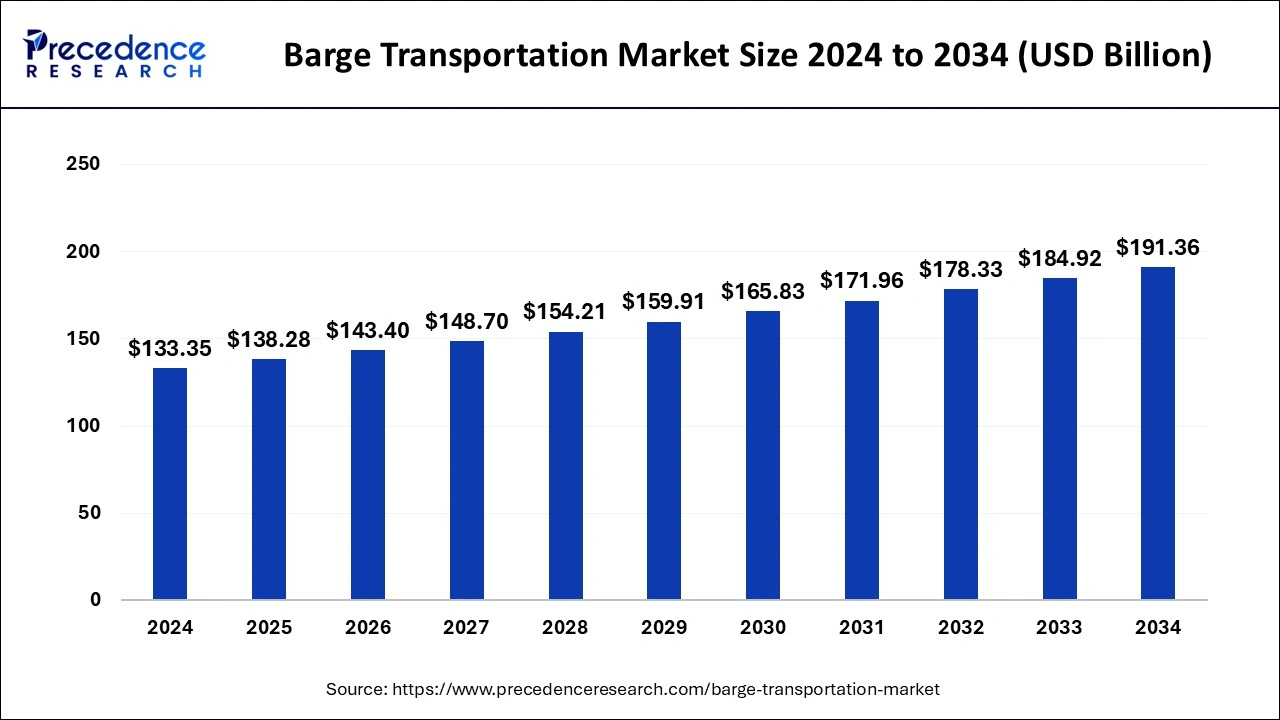The global Barge Transportation Market, valued at USD 133.35 billion in 2024, is expected to reach USD 191.36 billion by 2034, growing at a CAGR of 3.68%.
The Barge Transportation Market Critical Observations
- Europe dominated the global barge transportation market, holding a 72% market share in 2024.
- Tank barges accounted for over 25% of the total revenue share in 2024.
- The dry cargo segment led the market, securing the largest share in 2024.

Barge transportation plays a critical role in global trade, offering an economical and environmentally friendly method of transporting bulk commodities across inland and coastal waterways. The market is driven by the need for cost-efficient and fuel-saving logistics solutions, particularly in industries such as agriculture, mining, petrochemicals, and construction. Compared to rail and road transport, barges can move large quantities of goods with lower emissions, making them a preferred choice for businesses aiming to reduce their carbon footprint. The steady expansion of trade, increasing infrastructure projects, and advancements in vessel technology have further propelled the barge transportation industry.
Sample Link: https://www.precedenceresearch.com/sample/1043
Market Scope
| Report Highlights | Details |
| Market Size in 2024 | USD 133.35 Billion |
| Market Size by 2034 | USD 191.36 Billion |
| Growth Rate from 2025 to 2034 | CAGR of 3.68% |
| Largest Market | Asia Pacific |
| Base Year | 2024 |
| Forecast Period | 2025 to 2034 |
| Segments Covered | Barge Fleet, Product, Application, Region Type |
| Regions Covered | North America, Europe, Asia-Pacific, Latin America, and Middle East & Africa |
Core Factors
Several factors fuel the growth of the barge transportation market. One of the key drivers is the cost-effectiveness of barge transport. Since barges can carry heavy loads over long distances with minimal fuel consumption, they provide an economical solution, especially for bulk shipments like coal, crude oil, and agricultural goods. Additionally, environmental concerns and government regulations supporting sustainable transportation are pushing industries toward adopting waterway logistics. As road congestion worsens and fuel prices fluctuate, companies are shifting towards water-based transport to optimize supply chains. Moreover, the growth of international trade and industrialization, particularly in emerging economies, has created significant demand for barge services.
Potentials
With increasing investments in port infrastructure and inland waterways, new growth avenues are emerging in the barge transportation sector. The expansion of green logistics initiatives presents an opportunity for market players to innovate with energy-efficient and electric-powered barges. Additionally, technological advancements such as automated navigation systems and digital tracking solutions are enhancing operational efficiency, reducing delays, and improving cargo security. The rising adoption of containerized transportation via barges is another opportunity, enabling faster and more efficient goods movement in comparison to traditional bulk transport.
Obstacles
Regional Insights
The North American barge transportation market is well-established, with the United States being a major player due to its extensive inland waterways, particularly the Mississippi River system. The demand for barge transport in the region is driven by the movement of agricultural products, petroleum, and chemicals. Europe also sees significant barge activity, particularly along the Rhine and Danube rivers, where the emphasis on sustainable logistics is growing. Meanwhile, Asia-Pacific is experiencing rapid market growth, especially in countries like China and India, where industrial expansion and port infrastructure development are fueling demand for water-based logistics. In Latin America, barge transport is gaining traction due to growing exports of agricultural commodities such as soybeans, while the Middle East and Africa are witnessing an increase in crude oil and mineral transportation via barges.
Don’t Miss Out: Automotive Aftermarket
Industry Leaders
- SEACOR Holdings
- American Commercial Barge Line (ACBL)
- Ingram Marine Group
- Campbell Transportation Company
- Kirby Corporation
- APL Logistics
- Crowley Maritime Corporation
Recent Insights
The barge transportation industry has seen several notable developments in recent months. Governments across the globe are investing in waterway infrastructure development, improving ports and navigation systems to enhance cargo movement efficiency. There is also a growing push toward decarbonization, with companies experimenting with electric and hybrid barges to reduce emissions. Additionally, collaborations between shipping firms and technology providers are leading to advancements in smart tracking and automation, making barge transportation more competitive. The increasing focus on sustainability, coupled with digital transformation, is set to redefine the future of this industry in the coming years.
Market Segmentation
By Barge Fleet
- Covered
- Open
- Tank
By Product
- Liquid Cargo
- Dry Cargo
- Gaseous Cargo
By Application
- Agricultural Products
- Coal & Crude Petroleum
- Metal Ores
- Coke & Refined Petroleum Products
- Food Products
- Secondary Raw Materials & Wastes
- Beverages & Tobacco
- Rubber & Plastic
- Chemicals
- Nuclear Fuel
By Regional Outlook
- North America
- U.S.
- Canada
- Europe
- U.K.
- Germany
- France
- Asia Pacific
- China
- India
- Japan
- South Korea
- Rest of the World
